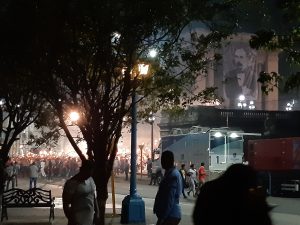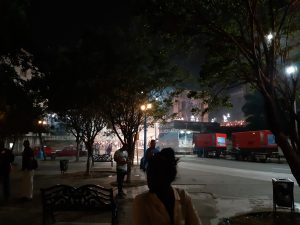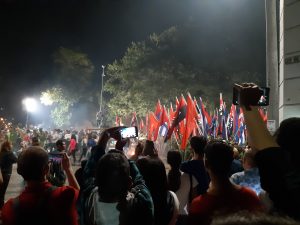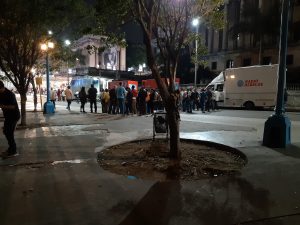
Students gather at the steps of la Universidad de La Habana carrying torches. A flag of José Martí is draped over the Philosophy Department building. The Cuban state has organised this event in celebration of the writer’s birthday.

The student crowds seen from behind the strict limits set by the state. The general public is not allowed any closer.
Spanish
Llegué a La Habana, Cuba, el 25 de enero. La ciudad no tardó mucho en sorprenderme con una festividad muy particular.
Solo dos días después de mi llegada, por la noche del 27 de enero, la ciudad empezó las celebraciones para el cumpleaños de José Martí. Nacido en el 28 de enero 1853, Martí era un periodista y revolucionario cuyos artículos rechazaban el mandato español en Cuba. Murió el 19 de mayo de 1895 durante la Batalla de Dos Ríos, mientras luchaba contra las fuerzas coloniales españoles. Para entender su significativo en la Republica Socialista actualmente, es necesario comprender que los socialistas cubanos perciben la historia cubana como una revolución singular y perpetua. Dicho en otras palabras, la revolución en contra del Imperio Español y la en contra de Batista fueron dos partes de la misma revolución. Por lo tanto, mientras que Martí criticaba mucho el socialismo, eso no le importa al estado cubano porque él sigue representando las ideas centrales de la revolución socialista: la libertad y la independencia cubana.
Se esperaba que las celebraciones empezaran con un grupo de estudiantes con antorchas en las escaleras de la Universidad de La Habana, y que eso se convirtiera en una marcha por los barrios hacia el Malecón (el paseo marítimo habanero). Fuimos a la universidad para ver el comienzo de la marcha. Pero, raramente, había un límite de al menos cincuenta metros alrededor de las escaleras universitarias y, como resultado, los árboles bloqueaban nuestra vista. Además, no había ninguna persona – ni entre los empleados del evento ni entre los que miraban los estudiantes desde lejos – que sabía cuándo empezaría la marcha.
Después de bastante tiempo esperando, un grupo de personas, que incluía el Presidente de La Federación de Estudiantes, llegó para dar unos discursos sobre José Martí. Dado la distancia entre nosotros y ese grupo, no entendimos mucho de lo que decía. Pero podía oír que cada uno de los gritos del Presidente terminó con, ‘¡Socialismo o muerte!’
Al final, el grupo empezó a marchar y creó un espectáculo deslumbrante – un río de fuego que fluía por las calles con un brillo suave y siniestro. Aunque los estudiantes habían respondido a cada oración en la universidad con un aplauso, mientras caminaban por las calles no parecían tan entusiásticos sobre el evento (muchos jóvenes pasaron la marcha mirando los móviles).
Quizás el fervor original en las escaleras fuera exhibido solamente para los oficiales estatales presentes allá. De hecho, con los límites estrictos, la luz artificial que iluminaba las escaleras, y la coordinación escrupulosa de los medios, el sentimiento de los estudiantes, tanto como la escena, se vio manufacturado.
Y todo eso ocultó los sentimientos reales y complejos del pueblo cubano sobre su país y su historia. Por un lado, existe una gran cantidad de orgullo sobre los logros de Cuba a pesar de su condición aislada, y un amor profundo para la patria – muchas veces expresado por música y baile. Por el otro, hay una frustración con la falta de servicios confiables y la poca disponibilidad de productos básicos como navajas y papas.
Nos unimos a la marcha cuando pudimos, y experimentamos un camino que, al reflexionar, parece sumar mi experiencia de La Habana hasta ahora: contradictorio. Mientras pasábamos por las calles teníamos: soldados y policía enfrente de nosotros; jóvenes que llevaban botellas plásticas, llenas de líquidos sin descripción, a nuestros lados; y escuchábamos un discurso sobre José Martí en las bocinas – el héroe nacional de un país socialista que odiaba el socialismo.

English
I arrived in Havana, Cuba, on 25 January. The city did not take long before surprising me with a very unique celebration.
Just two days after my arrival, on the night of 27 January, the city began celebrations for the birthday of José Martí. Born on 28 January 1853, Martí was a journalist and revolutionary whose articles rejected the Spanish rule of Cuba. He died on 19 May 1895 during the Battle of Dos Ríos, fighting against Spanish colonial forces. In order to comprehend Martí’s contemporary significance in the Socialist Republic, it is necessary to understand that Cuban socialists see Cuban history as a single, continuous revolution. In other words, the revolution against the Spanish Empire and the revolution against Batista were two parts of the same revolution. Therefore, whilst Martí was extremely critical of socialism, that does not matter to the Cuban state because he continues to represent the central ideas of the socialist revolution: Cuban freedom and independence.
It was expected that the celebrations would start with a group of students holding torches on the stairs of the University of Havana, and that this would turn into a march through the neighbourhoods towards the Malecón (Havana’s seafront road). We went to the university to watch the start of the march. But, strangely, there was a limit of at least fifty metres around the university stairs and, as a result, there were trees blocking our view. Furthermore, there was no one – neither amongst the event staff nor those watching the students from afar – who knew when the march would begin.
After a while waiting, a group of people, which included the President of the Student Federation, arrived to give speeches about José Martí. Given the distance between ourselves and this group, we did not understand much of what they were saying. However, I was able to hear that each cry from the President ended with, ‘Socialism or death!’

Journalists wait to be allowed access to the crowd. When given the cue, they sprint over.
Finally, the group began to march, and they created a shining spectacle – a river of fire flowing through the streets with a soft, sinister glow. Although the students had responded to each speech at the university with an applause, whilst they walked through the streets they did not seen as enthusiastic about the event (many young people spent the march looking at their phones).
Perhaps the original fervour on the steps was only exhibited for the state officials present there. In fact, with the strict limits, the stage lights that flooded the staircase, and the scrupulous coordination of the media, the sentiment of the students, as much as the scene, seemed manufactured.
And all of this hid the real and complex feelings of the Cuban people about their country and their history. On one hand, there exists a great measure of pride about the achievements of Cuba despite its isolated condition, and a deep love of the homeland – often expressed through music and dance. On the other hand, there is a frustration with the lack of reliable services and the low availability of basic products such as razors and potatoes.
We joined the march when we were able to, and we experienced a walk that, upon reflection, seems to sum up my experience of Havana up until now: full of contradictions. As we passed through the streets we had: soldiers and police in front of us; young people who were carrying plastic bottles, full of nondescript liquids, at our sides; and we listened to a speech about José Martí on loudspeakers – the national hero of a socialist country who loathed socialism.
